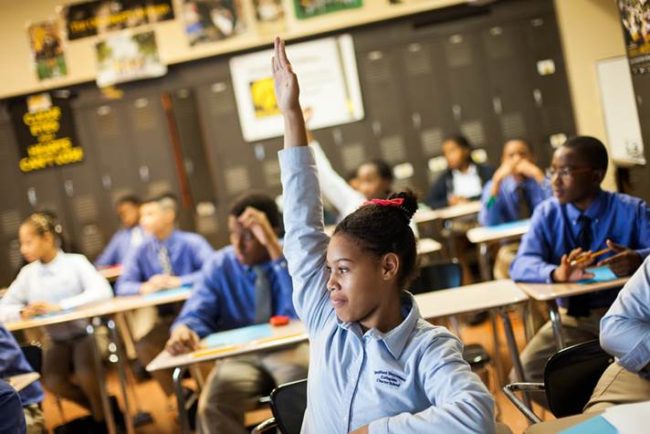10.20.17How Eric Snider Rolls Out His Discussion Procedures

Meaningful Discussions Require Strong Procedures
We’ve been watching a lot of footage of the first weeks of school lately—observing how top teachers set expectations and install systems that they’ll use throughout the year. We recently watched a clip of Achievement First Bushwick Middle School’s Eric Snider teaching his students to have productive discussions. My colleague Maggie Johnson loved it and was inspired to write this post.
Meaningful discussions are in many ways the heart of learning. And I was most definitely the teacher (I suspect I’m not alone) who dreamed about leading students in a discussion so compelling that Socrates himself would manifest in the back of my classroom and applaud. The reality was something closer to me, face down on my desk, lamenting a discussion that had devolved into a series of atomized responses, oblivious to the observations that came before them, repeated louder or more forcefully when emphasis was needed. An echo-chamber. As a teacher I realized that that calling something a Socratic Seminar wasn’t enough to inspire greatness—I would need to teach my students how to have a discussion.
That’s what makes this video of Eric Snider’s discussion roll out so inspiring to me.
EA.HOD.GR8.Snider.’HOD rollout.’Clip2731 from TLAC Blog on Vimeo.
A roll-out, to the TLAC team, is an explanation for students of the what-and-the-why for some classroom approach you are using. If you are Cold Calling, for example, you start by explaining to students how it works and why you do it.
But many teachers might not think to use a roll-out for their class discussions. Do the what-and-the-why really need explaining?
Well, if the purpose is to listen and develop ideas and not just talk past each other, quite possibly, yes.
Here for example, Eric starts, “We talk to learn from each other.” Making this simple and powerful notion explicit sets the stage for a year of horizon-expanding discussions in 6th grade reading class. “It’s by talking to each other, especially when we see something differently, that actually we’re going to learn the most.” Celebrating disagreement (and by default, error) from the get-go helps Eric establish a culture in which students feel empowered to take the intellectual risks that make great fodder for learning. This is a skill—he argues—not just crucial for their academic lives, but in life.
Eric doesn’t stop after underscoring the purpose of discussion. He then rolls out a system for engaging in discussion by explaining a basic expectations. First, students will paraphrase what the person before them said. This socializes students to carefully listen to one another and provides an entry point through which they can begin to synthesize their peers’ thinking with their own. He emphasizes the purpose of this—“it’s how we learn from each other.” Not to mention the added benefit of allowing Eric to Check for Understanding (i.e. does the students understand their peer’s argument?) and intervene to prevent the discussion from going unnecessarily afield.
Next, Eric outlines three other consistent prompts he’ll use to stretch students thinking and engineer robust discussions. “Prove It” (to prompt to support their argument with text evidence), “How?” (to push students in their explanation or interpretation of their evidence), and “Command the Room” (to remind students to speak audibly and engage their peers with their gaze).
Using these consistent prompts is an incredible act of self-discipline on Eric’s part, preventing him from inserting too much teacher talk in a discussion intended to unearth the deep thinking amongst his students. (Of course, he implicitly reserves the right to jump in with more directive questioning if the case requires.) Perhaps the greatest benefit of his framework is that it allows him to give specific and immediate feedback to students about their discussions, so that they might improve it as it unfolds.
Then—my favorite moment of all—Eric harnesses the anticipation he’s built and dives into a real discussion about a short story seemingly their first of the new school year. On his cue, we see all of the students in a densely filled room, turn and give their undivided attention to Arianna. After a moment, she speaks: “Tarik is not cruel because…”
It’s so good it gives me chills.
Of course, Eric’s students won’t master discussion in one iteration. He’ll need to reinforce these Habits of Discussion through prompting and feedback every day, until it becomes routine. And then there will be new discussion goals to master. What is certain, is that Eric takes has taken his students beyond the stilted sentence starters (“I agree” and “I disagree”) with a system for academic discourse that would make our ancient philosophers proud.

Thank you for this video modeling Habits of discussion!
Can you please make another one with sentence stems too!
*Discussion Fundamentals:
Voice, Tracking, Names
*Follow-on, and follow on prompting
*Sentence Starters
*Managing the meta
(borrowed form TLAC)